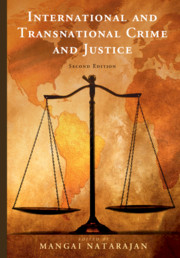Book contents
- International and Transnational Crime and Justice
- International and Transnational Crime and Justice
- Copyright page
- Contents
- Figures and Tables
- Preface
- About the Editor
- Notes on Contributors
- Introduction
- PART I OVERVIEW: TRANSNATIONAL CRIME
- PART IA Varieties of Transnational Crimes
- PART IB Transnational Organized Crime
- PART IC Factors that Facilitate Transnational Crimes
- PART ID Transnational Justice Matters
- PART II OVERVIEW: INTERNATIONAL CRIME
- PART III OVERVIEW: INTERNATIONAL AND TRANSNATIONAL CRIME RESEARCH
- World Map
- Index
- References
PART ID - Transnational Justice Matters
from PART I - OVERVIEW: TRANSNATIONAL CRIME
Published online by Cambridge University Press: 20 June 2019
- International and Transnational Crime and Justice
- International and Transnational Crime and Justice
- Copyright page
- Contents
- Figures and Tables
- Preface
- About the Editor
- Notes on Contributors
- Introduction
- PART I OVERVIEW: TRANSNATIONAL CRIME
- PART IA Varieties of Transnational Crimes
- PART IB Transnational Organized Crime
- PART IC Factors that Facilitate Transnational Crimes
- PART ID Transnational Justice Matters
- PART II OVERVIEW: INTERNATIONAL CRIME
- PART III OVERVIEW: INTERNATIONAL AND TRANSNATIONAL CRIME RESEARCH
- World Map
- Index
- References
- Type
- Chapter
- Information
- International and Transnational Crime and Justice , pp. 251 - 252Publisher: Cambridge University PressPrint publication year: 2019
References
FURTHER READING
REFERENCES
REFERENCES
REFERENCES
REFERENCES
WEBSITES
EUROPOL Main Site. www.europol.europa.eu.
Frontex Main Site. www.frontex.europa.eu.
US Customs and Border Protection Main Site. www.cbp.gov.
US Coast Guard Main Site. www.uscg.mil.
REFERENCES
WEBSITES AND READINGS
African Union. (2014). Convention on Cyber Security and Personal Data Protection.
Commonwealth of Independent States. (2001). Agreement on Cooperation in Combating Offences related to Computer Information.
Council of Europe. (2001). Convention on Cybercrime.
Council of Europe. Octopus Cybercrime Community. Retrieved from
www.coe.int/ka/web/octopus/country-wiki/.
League of Arab States. (2010). Arab Convention on Combating Information Technology Offences.
Shanghai Cooperation Organization. (2010). Agreement on Cooperation in the Field of International Information Security.
UNODC. Cybercrime repository. Retrieved from www.unodc.org/cld/v3/cybrepo/.
RECOMMENDED READING
WEBSITES
Acquis of the European Union in the field of Justice and Home Affairs (Title IV of the TEC and title VI of the TEU). http://europa.eu.int/comm/justice_home/acquis_en.htm.
Fact Sheets on the European Union. European Parliament. www.europarl.europa.eu/atyourservice/en/displayFtu.html?ftuId=FTU_4.2.6.html.
Police and Judicial Cooperation in the EU. EUR-lex. http://eur-lex.europa.eu/TodayOJ.



